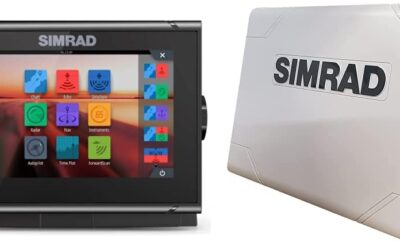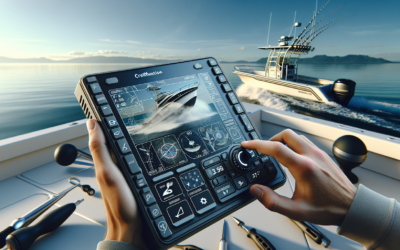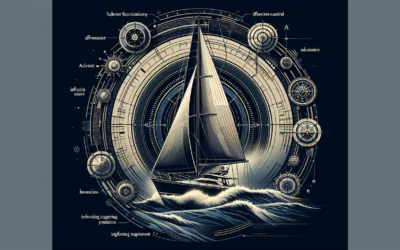Are you a beginner angler, eager to explore the world of fish finding? Look no further than “Setting Sail with Sonar: A Novice’s Guide to Fish Finding.” This comprehensive guidebook is your ultimate companion in navigating the depths of the water and uncovering the secrets of underwater life. Packed with practical tips, step-by-step instructions, and expert advice, this invaluable resource will empower you to master the art of sonar technology and become a skilled fisherman in no time. Get ready to embark on an exciting adventure and discover the wonders that await beneath the surface.
Understanding Sonar
What is Sonar?
Sonar, short for “Sound Navigation and Ranging,” is a technology used for detecting and locating objects underwater. Originally developed for military purposes, sonar has become an essential tool for fishing enthusiasts to find and target fish. By emitting sound waves into the water and measuring how long it takes for the waves to bounce back, sonar systems can create detailed images of the underwater environment.
How Does Sonar Work?
Sonar systems consist of a transducer, display unit, and various settings to customize the operation. The transducer transmits sound waves into the water, and when these waves encounter objects or fish, they bounce back as echoes. The echoes are picked up by the transducer, which converts them into electrical signals. The display unit then processes these signals to create a visual representation of the underwater environment.
Types of Sonar Systems
There are different types of sonar systems available, each designed for specific purposes. Traditional sonar, also known as 2D sonar, provides a basic representation of the underwater area, displaying fish arches and structure. CHIRP sonar, on the other hand, offers higher resolution and greater target separation, making it ideal for locating fish with precision. Side imaging sonar provides detailed, wide-angle views of the underwater terrain, while down imaging sonar offers a more focused, high-definition image directly beneath the boat.
Choosing the Right Sonar System
Considerations for Beginners
When choosing a sonar system, beginners should consider their budget, fishing style, and the type of water they will be exploring. While advanced features can be enticing, it’s important to focus on the functionalities that align with your fishing needs. For beginners, a simple and user-friendly interface is crucial to make the learning process smoother.
Different Types of Sonar Systems
Before investing in a sonar system, it’s essential to understand the different types available. 2D sonar is a popular choice for beginners due to its simplicity and affordability. CHIRP sonar provides more detailed images and is suitable for those looking for a more advanced system. Side imaging sonar is ideal for exploring expansive areas, while down imaging sonar is perfect for focusing beneath the boat. Considering the fishing environment and your personal preferences will help you determine which type of sonar system is right for you.
Features to Look for
When selecting a sonar system, there are several features to consider. Look for a system with a high-resolution display that allows for clear visibility even in bright sunlight. Adjustable settings such as sensitivity and frequency will enable you to fine-tune the system to your specific needs. GPS and chartplotting capabilities can be valuable additions, as they help you mark waypoints and navigate more effectively. Additionally, consider the power output and depth capabilities of the sonar system to ensure it meets the requirements of your fishing adventures.
Basic Sonar Operation
Installing Your Sonar System
Installing a sonar system may seem daunting, but with proper instructions and guidance, it can be easily accomplished. Begin by selecting a suitable location for the transducer, ensuring it is securely mounted on the boat’s hull. The display unit should be positioned in a convenient and easily accessible location. Following the manufacturer’s instructions, connect the transducer to the display unit, ensuring all connections are secure. Finally, power up the system and follow the on-screen prompts to complete the installation process.
Understanding the Display
To effectively operate a sonar system, it’s crucial to understand the information displayed on the screen. The display typically shows a graphical representation of the water column, with fish arches, structures, and the bottom displayed. Each sonar system has its own unique way of representing this information, so familiarizing yourself with the symbols and icons used is essential. Pay attention to color variations, as they can indicate differences in the strength of the echoes received.
Adjusting Settings for Optimal Performance
To get the most out of your sonar system, it’s important to adjust the settings based on your fishing conditions. Start by adjusting the sensitivity, which determines the system’s ability to detect weak echoes. Fine-tuning the sensitivity will help reduce unwanted noise while maintaining a clear image. Experimenting with the frequency settings can also enhance the level of detail displayed and the system’s ability to differentiate between targets. Consider adjusting other settings such as zoom, depth range, and chart speed to further optimize the performance of your sonar system.
Interpreting Sonar Readings
Identifying Fish Arch
One of the primary goals of using sonar is to identify fish. Fish arches are one of the most common sonar readings that indicate the presence of fish. A fish arch appears as an elongated curve on the display, typically in the middle or upper part of the water column. Understanding the size, shape, and thickness of fish arches will help you differentiate between various species and determine their approximate size. By interpreting the fish arches accurately, you can increase your chances of a successful fishing trip.
Differentiating Fish from Structure
In addition to fish arches, sonar systems also display structures such as rocks, vegetation, and the bottom of the water body. These structures can sometimes be mistaken for fish, especially when they appear as solid objects on the display. However, structures typically have a distinct appearance, lacking the characteristic arch shape. Familiarizing yourself with the different structures commonly encountered in your fishing environment will help you differentiate them from actual fish.
Mapping Underwater Terrain
Sonar systems can assist in creating detailed maps of the underwater terrain, allowing you to navigate more effectively and locate productive fishing spots. By interpreting the variations in depth readings, you can identify drop-offs, humps, and other topographical features that attract fish. Utilize the mapping functions of your sonar system to save and mark key locations on the water body. These maps can serve as valuable references for future fishing trips and help you develop a better understanding of the underwater landscape.
Locating Fish with Sonar
Identifying Fish Behavior Patterns
To effectively locate fish using sonar, it’s essential to understand their behavior patterns. Fish tend to school together, so locating one fish often means there are more nearby. Pay attention to the depth at which fish are found, as this can indicate their preferred habitat. Additionally, observe the movement patterns of fish displayed on the sonar to determine if they are actively feeding or simply passing through. By identifying and understanding fish behavior patterns, you can position yourself for a successful catch.
Targeting Different Depths
Fish can be found at various depths depending on factors such as water temperature, time of day, and the species being targeted. Experiment with adjusting the depth range on your sonar system to explore different layers of the water column. By scanning multiple depths, you can increase the chances of locating active fish. Keep in mind that different fish species have specific depth preferences, so familiarize yourself with the habits of your target fish to effectively target them at the desired depth.
Using Sonar to Locate Schools of Fish
One of the advantages of using sonar is the ability to identify schools of fish. These densely packed groups of fish can provide excellent fishing opportunities. When you come across fish arches on the sonar display, pay attention to their proximity to each other. If the arches appear close together and form a dense cluster, it’s likely that you have located a school of fish. Targeting these areas allows you to increase your chances of multiple catches and a rewarding fishing experience.
Advanced Sonar Techniques
Utilizing CHIRP Sonar Technology
CHIRP sonar technology is a more advanced and highly effective sonar system that provides superior target separation and image clarity. Unlike traditional sonar, which emits a single frequency, CHIRP sonar emits a continuous range of frequencies. This wider range of frequencies enhances the system’s ability to distinguish between different targets with higher precision. By utilizing CHIRP sonar technology, you can achieve clearer and more detailed images of the underwater environment, ultimately improving your fishing success.
Understanding Side Imaging
Side imaging sonar provides a wide-angle view of the underwater terrain on either side of the boat. This technology offers detailed imaging, allowing you to identify underwater structures, vegetation, and potential fish-holding areas with exceptional clarity. By understanding and interpreting side imaging sonar readings, you can effectively explore larger areas, locate hidden structures, and make more informed decisions about where to fish.
Using Down Imaging to your Advantage
Down imaging sonar focuses on creating high-definition images directly beneath your boat. This technology enables you to see intricate details of the underwater environment, including fish, structure, and vegetation. By utilizing down imaging, you can accurately identify nearby fish and their behavior, as well as distinguish the various types of structures and underwater features. Understanding how to interpret down imaging sonar readings can significantly increase your chances of finding and catching fish.
Optimizing Sonar Readings
Reducing Clutter and Noise
Sonar readings can sometimes be affected by clutter and noise, which can obscure important details and make interpretation difficult. To reduce clutter, adjust the sensitivity settings of your sonar system to filter out unwanted signals. Additionally, ensure that the transducer is installed correctly and free from any obstructions that may interfere with signal clarity. Avoid operating the sonar system simultaneously with other electronic devices on the boat to minimize interference and noise.
Adjusting Sensitivity and Frequency
Fine-tuning the sensitivity and frequency settings of your sonar system is essential for optimal performance. Adjust the sensitivity level to a point where it effectively detects fish echoes while minimizing noise and false readings. Experiment with different frequency settings to find the best balance between target separation and image clarity. Higher frequencies are perfect for shallow waters and better target separation, while lower frequencies are more suitable for deeper waters and penetrating through structures.
Utilizing Fish ID and Fish Alarms
Many sonar systems offer features such as Fish ID and fish alarms, which can assist in quickly identifying potential fish targets. Fish ID icons display simplified representations of fish rather than traditional arches, making it easier for beginners to identify fish on the screen. Fish alarms provide audible alerts when fish are detected, allowing you to focus your attention on fishing rather than constantly monitoring the display. Utilize these features to enhance your fishing experience and make the most of your sonar system.
Sonar Maintenance and Troubleshooting
Keeping Your Sonar in Good Condition
Proper maintenance of your sonar system is crucial to ensure its longevity and optimal performance. Regularly clean the transducer and display unit to remove any dirt, debris, or algae that may hinder signal transmission or visibility. Check all connections and cables for any signs of damage or corrosion, and replace them if necessary. Store your sonar system in a dry and secure location when not in use, and follow the manufacturer’s recommendations for periodic maintenance and software updates.
Common Issues and Solutions
Despite regular maintenance, you may encounter common issues with your sonar system. If you experience erratic readings or a loss of signal, check the transducer’s alignment, as slight adjustments may be necessary. Ensure that the batteries are properly charged or replace them if needed. If you encounter persistent issues, consult the manufacturer’s troubleshooting guide or seek professional assistance to diagnose and resolve the problem effectively.
Calibrating and Updating Your Sonar System
To achieve accurate readings and optimal performance, it’s important to calibrate your sonar system. Follow the manufacturer’s instructions to calibrate various settings such as depth, temperature, and speed, ensuring that the system is accurately displaying the information. Additionally, regularly check for software updates provided by the manufacturer. Updating the system’s software can enhance its functionality, add new features, and address any bugs or issues identified by the manufacturer.
Using Additional Fish Finding Tools
GPS and Chartplotters
Incorporating GPS and chartplotters into your sonar setup can significantly enhance your fishing experience. GPS allows you to mark waypoints, save fishing spots, and navigate more efficiently on the water. Chartplotters provide detailed maps of your fishing area, helping you identify underwater structures, contours, and navigation hazards. When combined with sonar, GPS and chartplotters offer a comprehensive fishing toolset, empowering you to find fish with precision and confidence.
Fish Finders and Combos
Fish finders are devices specifically designed for fish detection and location. These dedicated tools often combine sonar technology with additional features such as GPS, chartplotters, and depth sounders. Fish finders provide a simplified interface and a specialized set of functions tailored to fish finding. Consider adding a fish finder to your sonar setup for a more focused and precise fishing experience.
Adding Radar to your Setup
While sonar is primarily used for locating fish underwater, radar can assist in detecting fish and other objects above the water’s surface. Radar systems emit radio waves, which bounce off objects and return to the boat, providing a visual representation on the display. This added capability allows you to locate birds, floating debris, and other boats, potentially leading you to areas where fish are feeding. Adding radar to your sonar setup can offer a more comprehensive view of your fishing environment and increase your chances of success.
Best Practices and Tips for Success
Learning from Local Experts
To enhance your fishing skills and knowledge of sonar, seek guidance from local experts and experienced anglers. They can offer valuable insights into the fishing techniques, equipment, and strategies that work best in specific areas. Engage in fishing communities, attend seminars, and participate in local fishing events to learn from those who have a deep understanding of the region and its fish population.
Exploring Different Fishing Techniques
Sonar provides opportunities to explore various fishing techniques and experiment with different approaches. Try trolling, casting, or bottom fishing in different locations to understand how fish respond to different techniques. Vary your bait, lure choice, and presentation to determine what triggers the most bites. By continually exploring and refining your fishing techniques, you can adapt to changing conditions and increase your chances of success.
Continuous Learning and Experimentation
Sonar technology continues to evolve, and there is always something new to learn. Stay updated with advancements in sonar systems, features, and fishing techniques by reading industry publications, following online forums, and engaging with fellow anglers. Experiment with different sonar settings, interpret readings accurately, and adjust your fishing strategies accordingly. By maintaining a mindset of continuous learning and experimentation, you can maximize your fishing potential and become a more successful angler.
In conclusion, sonar technology is a powerful tool that can revolutionize your fishing experience. Understanding the basics of sonar operation, optimizing sonar readings, and utilizing advanced techniques will enhance your ability to locate and catch fish. By choosing the right sonar system, familiarizing yourself with its features, and continuously learning and experimenting with different techniques, you can set sail with confidence and embark on fulfilling fishing adventures.












